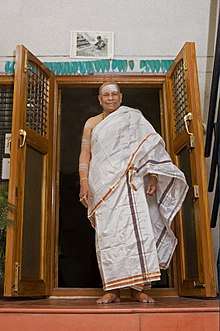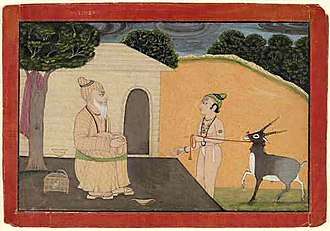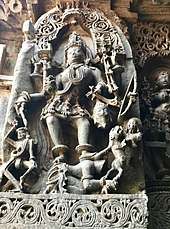Sexual abuse by yoga gurus
Sexual abuse by yoga gurus is the exploitation of the position of trust occupied by a master of any branch of yoga for personal sexual pleasure. Allegations of such abuse have been made against gurus in international yoga as exercise such as Bikram Choudhury,[3] John Friend,[3] Kausthub Desikachar,[3] Amrit Desai,[4] and K. Pattabhi Jois.[4] There have been some criminal convictions and lawsuits for civil damages.
The role of the guru has changed from the traditional restrained one-to-one relationship of hatha yoga to one of unrestrained celebrity yoga teachers in close contact with strangers anywhere in the world, a very different social structure. This altered relationship, according to some scholars, is among the causes of the abuse. In America and Britain, governing bodies have published policies covering sexual misconduct.
Multiple allegations

The Indian Express, listing allegations of sexual abuse against multiple yoga gurus (Bikram Choudhury, creator of Bikram Yoga;[7] John Friend, creator of Anusara Yoga; Kausthub Desikachar, grandson of the "father of modern yoga"[8] Krishnamacharya; and Swami Satchidananda, noted that several other gurus had been similarly accused, but released "without a befitting punishment".[3] Other sources listed those same gurus, and named others including Satya Sai Baba; Amrit Desai, creator of Kripalu Yoga; Muktananda, founder of Siddha Yoga; Swami Shyam, a Vedic meditation guru; Swami Rama, founder of the Himalayan Institute of Yoga Science and Philosophy; and Swami Akhandananda at one of Swami Satyananda's ashrams,[4][9][10] noting "the deafening silence in the US yoga community [about sexual abuse by yoga gurus] and widespread failure to acknowledge these allegations."[4] The Daily Telegraph, reporting on the Australian Royal Commission into Institutional Responses to Child Sexual Abuse, stated that Swami Satyananda "engaged in 'aggressive, violent sex' with numerous women and may have raped a seven-year-old" child.[11] The San Francisco Chronicle recorded allegations that Rodney Yee had had affairs with some of his students.[12] Shankarananda was reported to have had "tantric" sex with some 40 of his yoga school pupils.[13][14]
Yoga Journal accused K. Pattabhi Jois, founder of Ashtanga Vinyasa Yoga, of making different adjustments of yoga postures for his female students than for men.[5] CounterPunch magazine called Jois a "reported sexual abuser of students."[6] YogaDork stated that Jois touched women inappropriately,[15][16] as did Yoga Journal,[5] The Walrus magazine,[17] and YogaCity NYC.[18]
There have been some criminal convictions and lawsuits for civil damages. For example, an Indian guru, Asaram Bapu, who has some 400 ashrams around the world, was sentenced to life imprisonment in 2018 for rape by a court in Jodhpur,[19] and at least six women have brought sexual assault lawsuits against Choudhury. In 2016 he was ordered to pay Minakshi Jafa-Bodden over $900,000 for sexual harassment and her dismissal from the ashram.[20]
Debate over causes
The changing role of the guru

Yoga as exercise was created by the blending of Western styles of gymnastics with postures from Haṭha yoga in India in the 20th century, influenced by the popular physical culture of the time.[22] Before then, hatha yoga had been practised in secret by solitary, ascetic yogins, learning the tradition as a long-term pupil or shishya apprenticed to their master or guru.[23][24][25][26]
The scholars of modern yoga Mark Singleton and Ellen Goldberg comment that the globalisation of yoga has radically changed the nature and role of the guru. The medieval relationship between guru and shishya was one-to-one, well-understood in traditional Hindu society, based on trust developed over many years of instruction. The modern situation may bring the celebrity yoga teacher into close contact with strangers, anywhere in the world, in "milieus where the religious affiliations, function, status, and role of the guru may not be well understood" and accordingly, the old restraints are no longer in place.[21] They note that the western world is distrustful of the guru system, not least because of the many guru scandals concerning money, sex, and power. Modern western political and social beliefs, such as egalitarianism and the individualisation of the religious (finding "one's own truth") that they call "spiritual empiricism", also militate against respecting gurus, or indeed having one at all; the prevailing attitude is, they suggest, summed up in the title of the psychiatrist Anthony Storr's 1997 study of gurus, Feet of Clay. In India, too, the great wealth of some celebrity gurus has attracted suspicion, just as in the West.[21]
Social mechanisms

The researcher Amanda Lucia, writing in the Journal of the American Academy of Religion, analyses how the pupil's desire to be close to the guru and to "sacralize" bodily contact with the guru, along with authoritarian relationships between guru and pupils, facilitate sexual abuse by creating suitable social situations. She argues that instead of seeking causes in the personality or psychology of individual gurus, the root cause is "structural aspects of guru-disciple physicality, haptic logics, which tend to produce these social effects."[27] Lucia notes that one element of this is the guru's charisma as described by Max Weber, reinforced by Émile Durkheim's concept of the way that the sacred is "generated, concentrated, and apotheosized."[27] She observes further that the spiritual power of gurus is created by belief among their devotees that they embody "cosmic energetic forces", personified in Hinduism as the goddess Shakti.[27] She quotes Tulasi Srinivas on how devotees physically longed for proximity to the guru Sai Baba, experiencing the sight of him in darshan as "like receiving an electric charge",[27] and observes that "In modern global Hinduism, guru sex scandals have become so ubiquitous that they have become the foremost representation of the guru, certainly in the popular media", giving a long list of well-known gurus in the 2010s, and another list of those of an earlier generation in the 20th century.[27]
The yoga scholar Andrea Jain cites what Joel Kramer and Diana Alstad wrote in their 1994 book The Guru Papers, that the guru-disciple relationship is dangerous because it embodies "the seductions, predictable patterns, and corruptions contained in any essentially authoritarian form".[29][30] Jain however suggests that "surrender to a guru and his or her spiritual wares is not necessarily quantitatively or qualitatively different than surrender to a brand",[31] both being linked to a person such as a guru, business leader, or "simply a celebrity".[31]
Policy
The Yoga Alliance has published a policy on sexual misconduct; it describes the types of conduct considered inappropriate for yoga teachers in America, and the procedures for reporting, reviewing, and investigating a grievance. It defines sexual misconduct as "Unwelcomed conduct of a sexual nature, whether physical or verbal in nature."[32] It states that it is impossible to list all situations that might form such misconduct, but gives examples such as sexual advances with or without touching, sexual jokes, comments about sexual orientation, and questions about a person's sexual experiences. The Yoga Alliance notes that it does not have the powers or resources of a country's law enforcement agencies, and encourages people to make use of those systems. Violations of the policy can be punished by actions from education in correct conduct up to "revocation of Yoga Alliance membership and credentials".[32]
The British Wheel of Yoga's 'Equality and Diversity Policy' contains a section on Harassment, which describes the types of conduct that the British Wheel of Yoga, as the governing body of yoga in Britain, considers inappropriate for yoga teachers. It defines harassment as "any form of unwanted or unwelcome behaviour that violates people’s dignity or creates an intimidating, hostile, degrading, humiliating or offensive environment."[33] A complaints procedure enables any person to raise a complaint about such treatment, and the equality and diversity policy states that disciplinary action will be taken if the policy is violated.[33]
References
- Murphy, Jen (18 April 2018). "The 10 Rules of Hands-On Adjustments for Yoga Teachers". Yoga Journal.
- "By The New York Times"; Miller, Joe (11 February 2011). "City Room City Room Blogging From the Five Boroughs In Yoga, Touch Is for Teaching and Support". The New York Times.
hands-on adjustment ... opens the possibility of misinterpretation.
- "International Yoga Day: 5 yoga gurus who were accused of sexual assault". Indian Express. 21 June 2018.
- Park, Tosca (11 February 2015). "Modern Yoga: Turning a Blind Eye on Sexual Abuse Allegations?". Yoga Basics.
Other yoga masters have also been involved in sexual abuse scandals with their students, notably, Kausthub Desikachar, Sai Baba, Swami Shyam, Swami Satchidananda, Swami Rama, Swami Muktananada, and Amrit Desai.
- Yoga Journal Staff (12 February 2018). "#TimesUp: Ending Sexual Abuse in the Yoga Community". Yoga Journal. Retrieved 18 February 2019.
Yoga teacher Judith Hanson Lasater: [While I was] doing drop-backs from Tadasana (Mountain Pose) to Urdhva Dhanurasana (Wheel Pose) [Jois] came over to help me and put his pubic bone against my pubic bone, so I could feel him completely. He had me do three or four drop-backs, and when I came up after the last one, I looked around and saw three of my students, who were in the class with me, looking at me, mouths hanging open.
- Lawrence, Stewart (19 April 2013). "The Travails of Yoga Mogul Bikram Choudhury". CounterPunch.org. Archived from the original on 7 May 2013. Retrieved 7 May 2013.
- Horton, Adrian (20 November 2019). "'He got away with it': how the founder of Bikram yoga built an empire on abuse". The Guardian.
- "Memories of a Master". YogaJournal.com. Retrieved 19 September 2019.
- "Yoga ashram didn't consider sex abuse a crime, royal commission told". The Guardian. 4 December 2014.
- Royal Commission into Institutional Responses to Child Sexual Abuse. "Case Study 21".
- Pearlman, Jonathan (4 December 2014). "Yoga guru was violent sexual abuser, Australia royal commission told". The Daily Telegraph.
- Goodyear, Charlie; Marech, Rona (12 May 2002). "Yoga guru in compromising position / Celebrity instructor Rodney Yee faces allegations of misconduct with students". The San Francisco Chronicle.
- "'Secret' sex shakes yoga school", Keith Platt, Mornington Peninsula News, 20 January 2015. Retrieved 23 June 2015.
- "Guru sex scandal at Mt Eliza yoga retreat", Miki Perkins, The Age, 20 January 2015. Retrieved 23 June 2015.
- "Good Touch, Bad Touch: Gurus, Power, and Adjusting vs. Groping on the Yoga Mat". YogaDork. 9 December 2010. Archived from the original on 23 September 2011.
- "Yoga Teacher FAIL…Is that Pattabhi Jois? [photo]", YogaDork, 14 September 2009, archived from the original on 5 June 2012
- Remski, Matthew. "Yoga's Culture of Sexual Abuse: Nine Women Tell Their Stories". The Walrus. Retrieved 18 February 2019.
- Lucas, Anneke. "The Question Of Gurus: Who's Got The Power?". YogaCity NYC. Archived from the original on 27 March 2013.
- "Asaram Bapu: Indian guru sentenced to life for raping girl". BBC. 25 April 2018.
A self-styled Indian spiritual guru who claims millions of followers worldwide has been given a life sentence for raping a 16-year-old girl.
- Lieberman, Samuel (26 January 2016). "Hot-Yoga Guru Ordered to Pay $925K in Sexual-Harassment Judgment". New York Intelligencer.
- Singleton, Mark; Goldberg, Ellen (2014). Singleton, Mark; Goldberg, Ellen (eds.). Introduction. Gurus of Modern Yoga. Oxford University Press. pp. 4–8. ISBN 978-0-19-993871-1.
- Singleton, Mark (2010). Yoga Body : the origins of modern posture practice. Oxford University Press. pp. 4–16. ISBN 978-0-19-539534-1. OCLC 318191988.
- Bühnemann, Gudrun (2007). Eighty-Four Asanas in Yoga: A Survey of Traditions. New Delhi: D. K. Printworld. pp. 20–21. ISBN 978-8124604175.
- Mallinson, James (2011). Knut A. Jacobsen; et al. (eds.). Haṭha Yoga in the Brill Encyclopedia of Hinduism. 3. Brill Academic. pp. 770–781. ISBN 978-90-04-27128-9.
- Singleton, Mark (2010). Yoga Body : the origins of modern posture practice. Oxford University Press. p. 173. ISBN 978-0-19-539534-1. OCLC 318191988.
- Neehan, Jack (21 March 2017). "Yoga: James Mallinson uncovers the ancient traditions of the great yogis". SOAS. Retrieved 5 March 2019.
- Lucia, Amanda (2018). "Guru Sex: Charisma, Proxemic Desire, and the Haptic Logics of the Guru-Disciple Relationship". Journal of the American Academy of Religion. 86 (4): 953–988. doi:10.1093/jaarel/lfy025.
- Foekema, Gerard (1996). A Complete Guide to Hoysaḷa Temples. Abhinav Publications. p. 59. ISBN 978-81-7017-345-8.
- Kramer, Joel; Alstad, Diana (2014). The Guru Papers : masks of authoritarian power. Frog Books. p. xiii. ISBN 1-58394-598-9. OCLC 869299879.
- Jain, Andrea (2018). Parsons, William B. (ed.). Yogi superman, master capitalist | Bikram Choudhury and the religion of commercial spirituality. Being Spiritual but Not Religious: Past, Present, Future(s). Taylor & Francis. p. 163. ISBN 978-1-351-60705-6.
- Jain, Andrea (2015). Selling Yoga : from Counterculture to Pop culture. Oxford University Press. p. 93. ISBN 978-0-19-939024-3. OCLC 878953765.
- "Policy on Sexual Misconduct". Yoga Alliance. 4 March 2019. Retrieved 8 May 2019.
- "Equality and Diversity Policy" (PDF). British Wheel of Yoga. July 2006. pp. 4–5.

